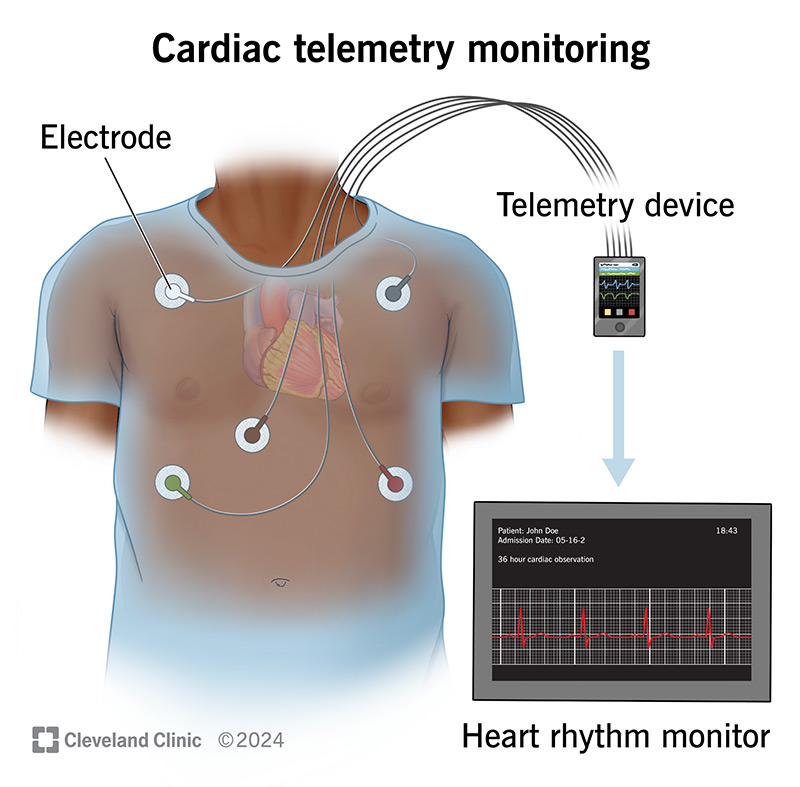Cardiac telemetry monitoring supplies data about your heart rhythm to help your provider make a diagnosis. Constant monitoring of your heart over a number of days improves the chances of catching an abnormal heart rhythm when it happens. With this information, a provider can treat the issue they find.
Advertisement
Cleveland Clinic is a non-profit academic medical center. Advertising on our site helps support our mission. We do not endorse non-Cleveland Clinic products or services. Policy

Cardiac telemetry monitoring is a way to get facts about your heart’s electrical activity continuously in a hospital’s cardiac telemetry unit. It collects data from a device that uses electrodes a healthcare provider sticks on your chest. Providers can look at the readings to find abnormal heart rhythms (arrhythmias). Alarms alert providers to dangerous heart rhythms.
Advertisement
Cleveland Clinic is a non-profit academic medical center. Advertising on our site helps support our mission. We do not endorse non-Cleveland Clinic products or services. Policy
There are many different abnormal heart rhythms. Some are more dangerous than others. Cardiac telemetry monitoring helps a provider identify the kind of abnormal heart rhythm you have. They can use this information to choose a treatment to get your heart back to a normal rhythm.
Healthcare providers use cardiac telemetry monitoring to get continuous readings from your heart while you’re in the hospital. They use this when they need to know about your heart’s rhythms for up to 30 days. This gives them a better idea about what your heart is doing over time. Other monitors (mostly used at home) like a Holter monitor only track your heart’s electrical activity for up to two days.
You may need cardiac telemetry if you:
Sensors on your skin send data through wires to a device. This device transmits the readings to a display monitor through a cable or wireless connection. A healthcare provider or telemetry monitor technician watches the screen in another room of the hospital. They can alert a provider if they see an abnormal heart rhythm.
Advertisement
Mobile cardiac telemetry sends information through WiFi or cell phone networks. This type of device may be in a necklace pendant, a patch or a belt on your chest. You can use this type of monitor at home.
A healthcare provider will:
Cardiac telemetry monitoring is painless, but the sticky patches may irritate your skin.
You may hear an alarm go off at times. The reasons for this vary. Sometimes, an alarm goes off because of the way you move or due to a poor signal when the device is sending data. Changing the electrode patches daily can help prevent these false alarms.
Other alarms indicate an abnormal heart rhythm. If this happens, a provider will come to your room to evaluate you.
When your provider has the information they need from cardiac telemetry monitoring, they’ll disconnect the wires and remove the sticky patches. You may have some sticky residue on your skin that you’ll need to wash off when you go home.
Risks or disadvantages of telemetry monitoring include:
Cardiac telemetry monitoring has these benefits:
If your provider finds an abnormal heart rhythm, they’ll tell you the name of it. They’ll explain what it means and how they can treat it. If your provider doesn’t find an abnormal heart rhythm, they’ll tell you. They may suggest other tests to find the cause of your symptoms.
Because telemetry monitoring is constant, you may get results any time you have an abnormal heart rhythm during the monitoring period. If you don’t have any abnormal heart rhythms, you may not get results until the monitoring time ends.
Advertisement
If you need treatment for an abnormal heart rhythm, your provider may prescribe medication that manages your heart rate or prevents arrhythmia.
Other treatments may include:
Contact your healthcare provider if you’re having trouble with the mobile cardiac telemetry monitor. You should also let them know if you continue to have symptoms of a possible arrhythmia.
Nurses’ duties in cardiac telemetry may include:
Yes. When healthcare providers talk about telemetry, it’s the same as cardiac monitoring. A telemetry unit in a hospital cares for people who need constant monitoring of their heart.
Advertisement
An electrocardiogram (EKG) only takes a reading of your heart rhythm for a few seconds. It can only show what’s happening in your heart during that short time. Cardiac telemetry monitoring lets providers gather more information over a longer period of time.
When you’re in the hospital, you want answers. What’s going on with my body? Why is this happening? Cardiac telemetry monitoring is a way to find answers to what’s happening in your heart. Although having electrodes on your chest isn’t an everyday thing, it’s necessary to get information for a diagnosis. Don’t hesitate to ask your healthcare provider any questions you have about your testing or results.
Advertisement
Cleveland Clinic’s primary care providers offer lifelong medical care. From sinus infections and high blood pressure to preventive screening, we’re here for you.

Last reviewed on 03/14/2024.
Learn more about the Health Library and our editorial process.